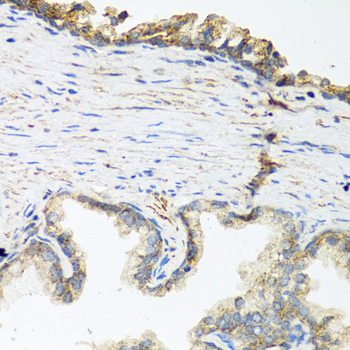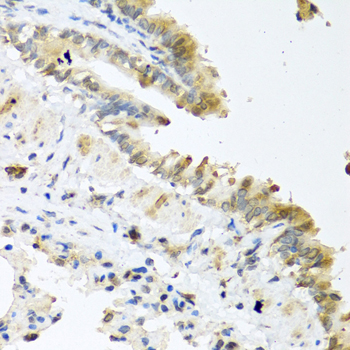-
Product Name
Wnt5a Polyclonal Antibody
- Documents
-
Description
Polyclonal antibody to Wnt5a
-
Tested applications
IHC
-
Species reactivity
Human, Mouse
-
Alternative names
WNT5A antibody; hWNT5A antibody; protein Wnt-5a antibody
-
Isotype
Rabbit IgG
-
Preparation
Antigen: Recombinant fusion protein containing a sequence corresponding to amino acids 101-380 of human Wnt5a (NP_003383.2).
-
Clonality
Polyclonal
-
Formulation
PBS with 0.02% sodium azide, 50% glycerol, pH7.3.
-
Storage instructions
Store at -20℃. Avoid freeze / thaw cycles.
-
Applications
IHC 1:50 - 1:100
-
Validations

Immunohistochemistry - Wnt5a Polyclonal Antibody
Immunohistochemistry of paraffin-embedded human prostate using Wnt5a antibody at dilution of 1:100 (40x lens).

Immunohistochemistry - Wnt5a Polyclonal Antibody
Immunohistochemistry of paraffin-embedded mouse lung using Wnt5a antibody at dilution of 1:100 (40x lens).
-
Background
Ligand for members of the frizzled family of seven transmembrane receptors. Can activate or inhibit canonical Wnt signaling, depending on receptor context. In the presence of FZD4, activates beta-catenin signaling. In the presence of ROR2, inhibits the canonical Wnt pathway by promoting beta-catenin degradation through a GSK3-independent pathway which involves down-regulation of beta-catenin-induced reporter gene expression (By similarity). Suppression of the canonical pathway allows chondrogenesis to occur and inhibits tumor formation. Stimulates cell migration. Decreases proliferation, migration, invasiveness and clonogenicity of carcinoma cells and may act as a tumor suppressor. Mediates motility of melanoma cells. Required during embryogenesis for extension of the primary anterior-posterior axis and for outgrowth of limbs and the genital tubercle. Inhibits type II collagen expression in chondrocytes (By similarity).
Related Products / Services
Please note: All products are "FOR RESEARCH USE ONLY AND ARE NOT INTENDED FOR DIAGNOSTIC OR THERAPEUTIC USE"
